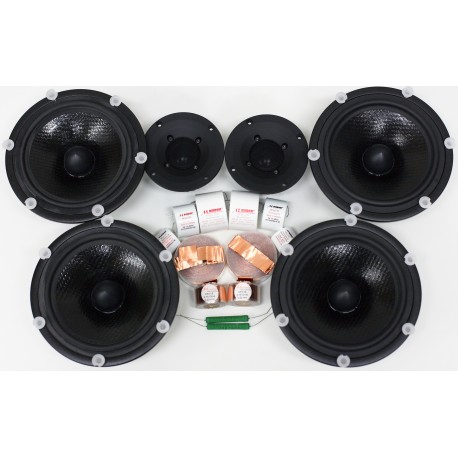Seas Bragi Kit with Mundorf MEO Capacitors, MR10 resistora and CFC16/14 Foil Coils, incl Seas Drivers
amed after Bragi, the skaldic god of poetry in Norse mythology.
The Bragi consist of two 18 cm long throw woofers with a Curv cone made of woven polypropylene and a 27 mm aluminium/magnesium dome with a DXT lens.
By popular demand we have made a big brother to our Idunn DIY-kit. This kit utilizes the same drivers as Idunn, but two woofers instead of one to give it even more punch in the bass.
The Bragi is intended to be used both in a home theater and a stereo setup. In a home theater setup the Bragi can be combined with the Idunn as rear and surround speakers since they have a matching sound character, or just use Bragi all the way around for that extra punch.
Bragi
Enclosure and stuffingThe Bragi uses a 30 litre vented cabinet to give it a nice roll-off with a good bass fundament. The cabinet has the same front size as the Idunn to complememnt them in a surround setup. Figure shows the cabinet drawings. Ask your local loudspeaker dealer if he can help you obtain this, if you are not thinking of building it yourself. The important thing to remember when you are building this, is to keep the baffle width and internal volume of the original enclosure. Adding braces to stiffen the cabinet is a good tip for the advanced builder to take the loudspeaker just a little bit further.
The amount of stuffing and port tuning is based on measurements and extensive listening. The cabinet is filled with 350 g of stuffing. The stuffing is distributed evenly in the box, but kept away from the port opening to allow free movement of air. This to ensure that the airflow noise stays as low as possible. The port length is 13 cm including both the inner and outer flanged end and the inner diameter is 5 cm. This gives a port tuning of 38 Hz providing a smooth low frequency roll-off.
Drive UnitsU18RNX/P is a 18cm (6.5") High Fidelity woofer with an injection moulded metal chassis, intended for bass reflex and transmission line designs. New Curv cone, a woven polypropylene with excellent internal damping together with perfectly matched moving parts gives a smooth, extended frequency response. Large magnet system gives good transient response, and the bumped back plate together with the very long, and light weight copper clad aluminium voice coil allow for extreme coil excursion with low distortion. Bullet shaped phase plug reduces compression due to temperature variations in the voice coil, avoids resonance problems which would occur in the volume between the dust cap and the pole piece and increases the long term power handling capacity. Extremely stiff and stable injection moulded metal basket, keeps the critical components in perfect alignment. Large windows in the basket both above and below the spider reduce sound reflection, air flow noise and cavity resonance to a minimum. This driver uses Seas SpiderRing technology.
27TBCD/GB-DXT is a High Definition aluminium/magnesium alloy dome tweeter with DXT lens. An optimally shaped dome and a wide SONOMEX surround, both maufactured by SEAS, ensure excellent performance and consistency. The compensation magnet increases the sensitivity and reduces the magnetic strayfield and allows use in close proximity to CRT screens. A fine mesh grid protects the diaphragm. Stiff and stable rear chamber with optimal acoustic damping allows the tweeter to be used with moderately low crossover frequencies. This revolutionary DXT tweeter addresses the major issues regarding directivity control in traditional loudspeaker designs. DXT solves several well-know issues regarding; directivity control, off-axis response, integration with midrange units and baffle diffractions.
CrossoverThe crossover is symmetrical with a 2.6kHz crossover frequency. The crossover point was chosen so that the directivity of the drivers make the overall power response extremely smooth, as can be seen in the measurements.
Complexity of the crossover was held as low as possible witout sacrificing any of the audible perfomance. This is possible to achieve, because of the drivers very smooth response. The crossover is a simple 2nd order network with some fine tuning on the tweeter. Together they align the phase of the drivers excellent and gives a smooth interdriver transition.
The rolloff of the drivers is steep enough to alow them to work effortless even at high power levels, thus maintinaing the smooth and detailed sound quality at all levels and allowing them to be as dynamic as possible.
Schematics for the crossover are shown in the figure 1.
MeasurementsThe measurements are taken in free field at 1 metre on tweeter axis. Figure 2 shows the results of the measurements. As seen in the figure the average sensitivity is 89dB. The black curve shows the response with the tweeter connected with opposite polarity. The deep and symmetrical notch, when the tweeter is connected with inverse polarity, shows that the drivers are in-phase across the whole crossover region.
The off-axis respons of the Bragi is shown in figure 3. Here we really see the beauty of the DXT tweeter. The power response is perfectly smooth throughout the entire frequency range even at off-axis. This gives a huge sweet spot, while still allowing for pin-point imaging. It also keeps the tonal balance of the loudspeaker all over the listening room.
Figure 2: Anechoic free field response at 1m on tweeter axis 2.83V.
Figure 3: SPL at 1m, 2.83V, on- and off-axis
Figure 4: Harmonic distortion at 96dB SPL 1m on-axis














